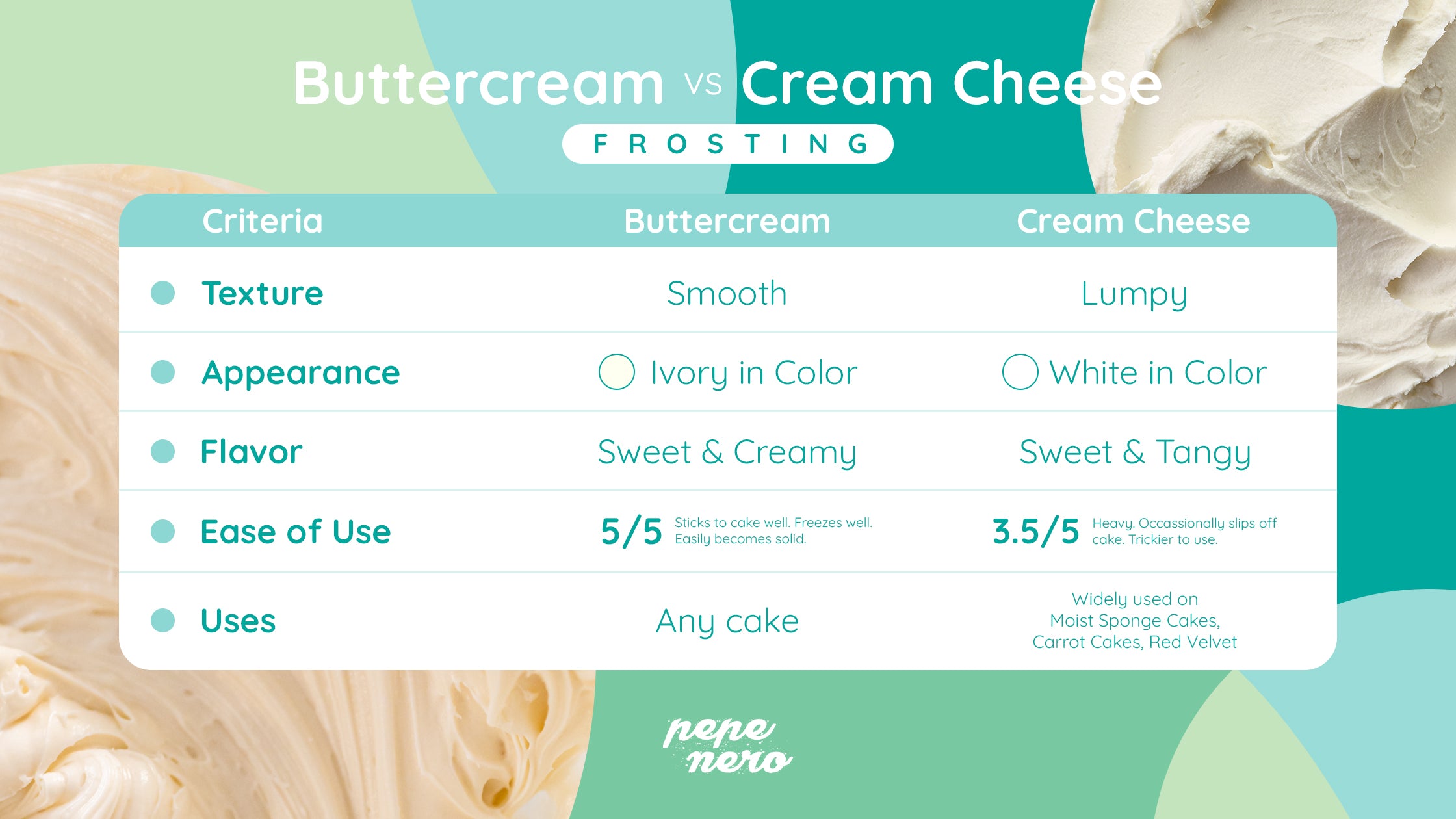Your Cart is Empty
FREE EXPEDITED SHIPPING
Whether you're an experienced baker or just starting out, cake decorating is a skill that requires some know-how. When it comes to decorating cakes, it's important to know the differences between two essential toppings: buttercream frosting and icing. Many people often confuse these two even though they're completely different. In this blog, we'll delve into the difference between the two.

Buttercream is a popular cake topping made mainly from butter and sugar, and sometimes with ingredients like cream, milk, or eggs to give it a silky and airy texture. There are different types of buttercream, like American Buttercream, Swiss Meringue Buttercream, Italian Meringue Buttercream, French Buttercream, or German Buttercream, depending on how they're made. You can also add various flavors like chocolate, vanilla, or strawberry to complement a baked cake.

Cream cheese frosting or cream cheese buttercream frosting is a versatile cake filler and topping that includes powdered sugar, butter, and cream cheese. It can also include other ingredients like mascarpone, vanilla extract, heavy cream, flavorings, and food coloring.
Because it is less dense and tangier than buttercream, this form of frosting is an excellent substitute for cakes that must be consumed immediately after being frosted. Cream cheese frosting goes great with a red velvet cake, chocolate cake, or carrot cake.
Buttercream and cream cheese frosting are popular cake toppings. Now that we know what they are, let's look at how they differ from one another:

The first obvious difference between cream cheese frosting and buttercream frosting is the texture. Since the main ingredient of buttercream frosting is butter, the texture is smooth and does not have any lumps.
On the other hand, cream cheese frosting is a bit lumpy and not as smooth. This is because cream cheese is a form of cheese that contains cheese curds. Despite using whipped cream cheese or spreadable cream cheese in its production, cream cheese frosting will never have the same silky, velvety texture as buttercream frosting.
At first glance, both cream cheese frosting and buttercream frosting appear to be similar. If you pay close attention and are experienced at making frostings, you can see a subtle difference in the appearance of the two. Due to the amount of butter used, cream cheese frosting is white while traditional buttercream icing is a bit ivory in color.

The flavors of buttercream and cream cheese frosting are one of their key distinctions. Buttercream is sweet and creamy. In comparison, cream cheese frosting has a sweet and tangy flavor.
When it comes to ease of use, buttercream is the winner. It sticks to the cake nicely, freezes well, and becomes solid without any trouble. It's also a joy to work with. On the other hand, cream cheese frostings are heavier and can occasionally slip off the cake, making it a little trickier to use.

In terms of pairings, buttercream frosting is unquestionably more versatile than cream cheese icing. This is due to the fact that while cream cheese frosting may be overly tangy in some recipes, buttercream has a neutral flavor.
Cream cheese frosting is widely used on moist sponge cakes including carrot cakes, red velvet, hummingbird cakes, and many others. However, buttercream frosting can be used on practically any cake, cupcake, and sheet cake, by simply adjusting the flavors.

It really depends on what you like. To figure out which one you prefer, make a batch of each and compare the results.
When properly mixed, buttercream has a tendency to be more firm and have a smoother finish. On the other hand, cream cheese frosting can be a little greasy, prone to lumps, and have an unusual texture. However, both cake coatings are good options, depending on the recipe used and what you like.
Yes, you can create unique cake designs by using both frostings together. For example, you can use buttercream for decorations and cream cheese frosting for the filling or vice versa.
Yes, both buttercream and cream cheese frosting can be stored in an airtight container in the refrigerator for a few days. Just let them come to room temperature and give them a good stir before using again.
Yes, you can find non-dairy cream cheese alternatives made from ingredients like soy or almond. These can be used to make dairy-free cream cheese frosting for those with dietary restrictions or preferences.
To fix lumps in cream cheese frosting, you can try using room-temperature cream cheese and butter, sifting the powdered sugar, and beating the mixture until smooth. If needed, a few seconds in the microwave can help soften the lumps, but be careful not to melt it.
Yes, both frostings can be prepared in advance and stored in the refrigerator. Just be sure to bring them to room temperature and give them a good mix before using to restore their smooth texture.
When it comes to cake decorating, knowing the differences between buttercream and cream cheese frosting is key. Buttercream is smooth, sweet, and versatile, while cream cheese frosting offers a tangy twist and pairs well with specific cakes. The choice between them ultimately depends on your preference and the recipe you're working with.
And for those looking to improve their cake decorating game effortlessly, consider Pepe Nero's exceptional baking kit. With Pepe Nero, you'll have all the essential tools at your fingertips to create stunning cakes with either buttercream or cream cheese frosting. Shop with us today.
Comments will be approved before showing up.
